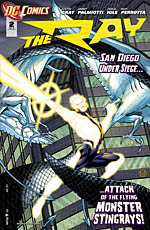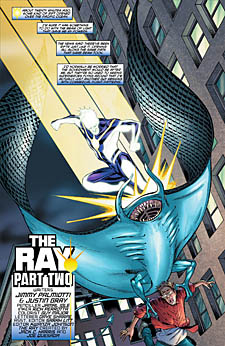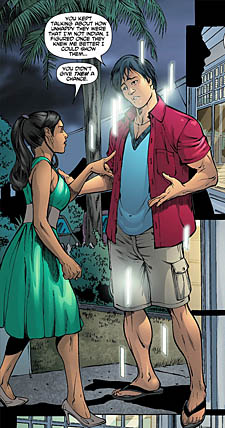 Written by Jimmy Palmiotti and Justin Gray
Written by Jimmy Palmiotti and Justin Gray
Penciled by Jamal Igle
Inked by Rich Perrotta
32 pages, color
Published by DC Comics
I still remember when DC published the revamp of The Ray back in the early ’90s, with Jack C. Harris and Joe Quesada taking the core concept and creating Ray Terrill, a new character with the power to transform into and manipulate light. With this new The Ray mini-series 20 years later, I’m getting a similar vibe from Jimmy Palmiotti, Justin Gray, and Jamal Igle. And that’s a very good thing indeed.
 Palmiotti and Gray’s main character of Lucien Gates opens his mini-series with an internal monologue to the reader, saying that the audience probably wants his origin story, because everyone has one, no matter how ridiculous. He then goes on to mention that at the moment, he’s fighting gigantic telepathic jellyfish. And that, to me, sums up The Ray. The writing here is light and fun, as we see that the accident that gave Lucien his superpowers also did all sorts of other strange things, like creating a two-story tell horned lizard, or the previously mentioned flying telepathic gigantic jellyfish. A lot of this story feels like an excuse to whip up bizarre things and throw them both at the reader and the main character.
Palmiotti and Gray’s main character of Lucien Gates opens his mini-series with an internal monologue to the reader, saying that the audience probably wants his origin story, because everyone has one, no matter how ridiculous. He then goes on to mention that at the moment, he’s fighting gigantic telepathic jellyfish. And that, to me, sums up The Ray. The writing here is light and fun, as we see that the accident that gave Lucien his superpowers also did all sorts of other strange things, like creating a two-story tell horned lizard, or the previously mentioned flying telepathic gigantic jellyfish. A lot of this story feels like an excuse to whip up bizarre things and throw them both at the reader and the main character.
Palmiotti and Gray write The Ray in a conversational, almost intimate style. It gives you the sensation that you’re being sat down with the main character and are listening to his rambling, never-ending saga. It’s a style that in comics is probably best associated with Christopher Priest’s work on comics like Quantum & Woody and Black Panther; since Priest himself wrote an ongoing The Ray series (and edited the Harris/Quesada mini-series), it’s a rather fitting approach to take.  This also isn’t a book that too concerned with the normal trappings of superhero books. The Ray focuses less on the flying mutant manta rays, and more on how Lucien’s trying to make his girlfriend Chanti’s parents like him (despite the fact that he’s not Indian, but in fact of Korean descent). And as a hook, I like it. Lucien and Chanti’s relationship feels real, and Lucien’s fumbling through figuring out his powers (controlled in part by meditation and yoga practices his hippy mother taught him) and how to deal with the fact that putting on clothes causes them to incinerate is entertaining. There’s something about The Ray‘s breezy style that makes me wish that this had been one of the launch titles for DC’s "New 52," because this is the sort of ongoing series I’d cheerfully read every month.
This also isn’t a book that too concerned with the normal trappings of superhero books. The Ray focuses less on the flying mutant manta rays, and more on how Lucien’s trying to make his girlfriend Chanti’s parents like him (despite the fact that he’s not Indian, but in fact of Korean descent). And as a hook, I like it. Lucien and Chanti’s relationship feels real, and Lucien’s fumbling through figuring out his powers (controlled in part by meditation and yoga practices his hippy mother taught him) and how to deal with the fact that putting on clothes causes them to incinerate is entertaining. There’s something about The Ray‘s breezy style that makes me wish that this had been one of the launch titles for DC’s "New 52," because this is the sort of ongoing series I’d cheerfully read every month.
Igle’s pencils are, as always, attractive. He’s got a good sense of anatomy (and let’s face it, as Lucien keeps vaporizing his clothes initially, we see a lot of anatomy here), the backgrounds look good, and most importantly Igle is able to bring across the sensation of speed whenever Lucien uses his power. Every time the Ray zooms off, it feels genuinely fast; considering this is a print medium, that’s no small feat. There are lots of good little touches too; the faint wrinkles around Lucien’s father’s eyes, for instance, or how a hovering Lucien is drawn in a streamlined manner that matches up with the diagonal zap of light in the next panel over.
I’m actually a tiny bit disappointed that we’re halfway through The Ray mini-series. This is fun, pure and simple, and Palmiotti, Gray, and Igle feel like they’re paying homage to the old Ray comics while still defining their own title character. The Ray might not be getting a snazzy "New 52" logo on its cover, but trust me, this is one of the better new comics to launch from the company these past few months. If you’re looking for a fun, darkness-free comic (both figuratively and literally), you can’t go wrong with The Ray.
